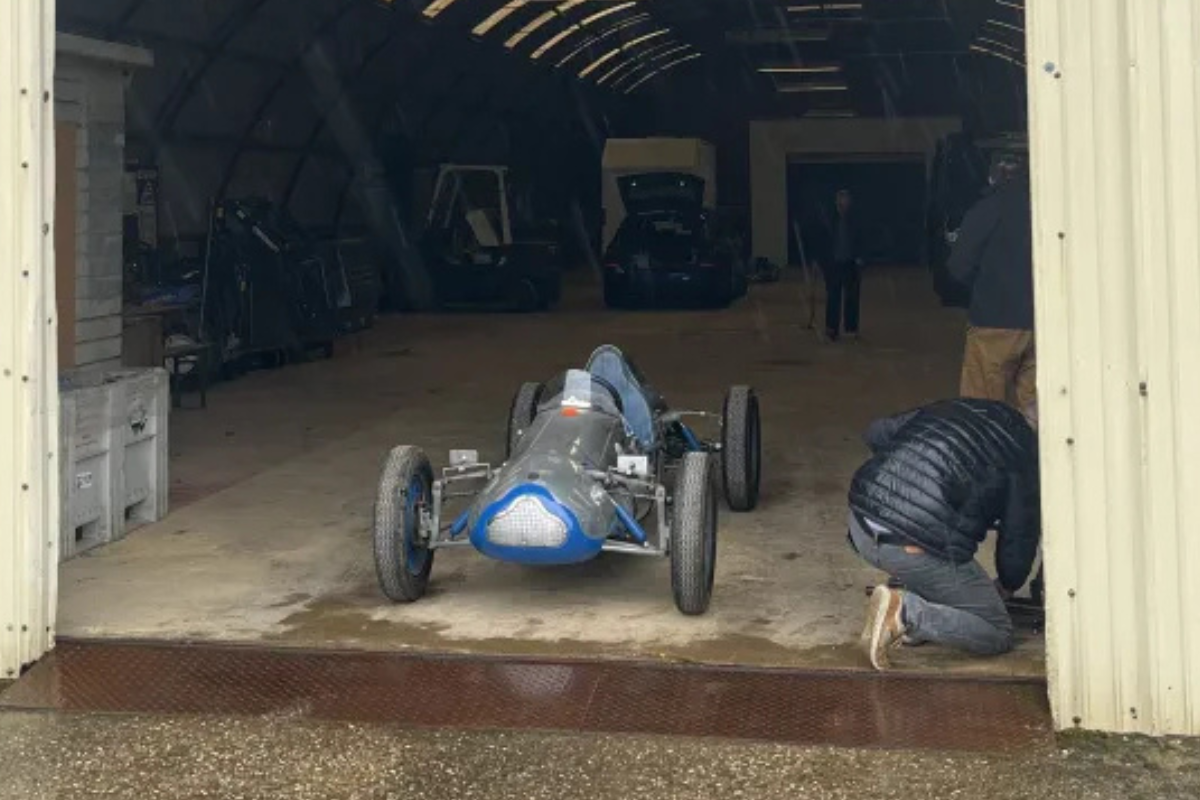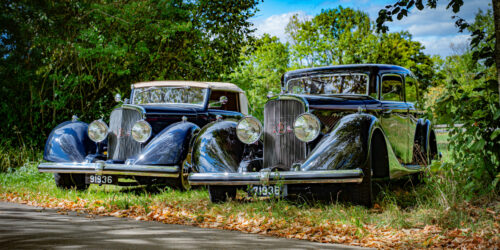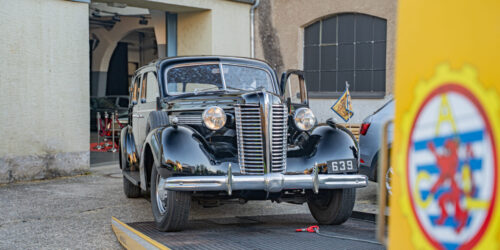From 22 to 24 August 2025, the Conservatoire National de Véhicules Historiques (CNVH) will be participating in the Silverstone Festival with a Cooper 500 Mk5. British racing driver Alan Brown won the Luxembourg Grand Prix in 1951 with this car. A look back at a highlight in the history of Luxembourg motorsport.
CNVH
The Cooper 500 Mk5 is a legendary Formula 3 racing car from 1951, whose historical significance is particularly linked to the prestigious Luxembourg Grand Prix.
British racing driver Alan Brown won the 1951 Luxembourg Grand Prix, a car race that many people are no longer familiar with today, in this car.
The Belgian Grand Prix at the Spa-Francorchamps circuit is widely known. Luxembourg had its own Grand Prix almost 70 years ago. The first edition, organised in 1939 under the name ‘Grand-Prix du Centenaire’, was part of the celebrations marking the centenary of Luxembourg’s independence.
After a break forced by the Second World War, the race resumed between 1949 and 1952. Alan Brown’s victory in 1951 with the Cooper 500 Mk5 remains a highlight of this short but significant era of Luxembourg motor racing.
Today, the Cooper 500 Mk5 is one of the CNVH’s most important exhibits, but it is not yet on public display. We are still preparing its presentation. It will be added to our permanent exhibition towards the end of the year. We look forward to presenting it in a setting that fully reflects its significance for national and international motorsport history.
CNVH
It is difficult to provide precise technical data for the Cooper 500 Mk5 from the 1950s, as these racing cars were often customised to the preferences of the racing teams or drivers. However, some general characteristics can be mentioned.
The engine is a JAP (JA Prestwich Industries) motorcycle engine, which was very popular in Formula 3 cars of that era.
It operates at a very high compression ratio and uses methanol as its main fuel. This enabled it to achieve higher performance than conventional petrol engines. Its range was relatively limited as methanol was consumed more quickly than petrol. However, this was sufficient for the typical short race tracks of Formula 3 at the time.
From a historical perspective, we are fortunate to be able to count on the support of Goy Feltes, who is considered an authority on the history of the Grand Prix in Luxembourg.
CNVH
CNVH
The Silverstone Festival is one of Europe’s most prestigious historic car events and is eagerly awaited every summer. It takes place at the legendary Silverstone race track in the United Kingdom and brings together fans from all over the world to celebrate the history and culture of motor racing.
The 2025 edition is particularly significant:
it marks the 75th anniversary of the Formula 1 Championship, which was launched at Silverstone in 1950. To mark the occasion, the festival is offering an exceptional programme. This includes races commemorating the great decades of Formula 1 and unique exhibitions tracing its development. Legendary cars will also be on display and drivers who have made history will be in attendance.
This year, the CNVH is taking part in this legendary festival for the first time – an invitation that we are particularly honoured to receive, as our Cooper 500 Mk5 single-seater finished second in the 1951 Silverstone Grand Prix. This direct link to the history of the circuit caught the attention of the organisers, who invited us to take part in this anniversary edition.
During this extraordinary weekend, visitors will be able to admire historic vehicles of all categories, attend concerts, meet sporting legends and enjoy a festive atmosphere that combines history, adrenaline and emotion.
Our participation in the Silverstone Festival 2025 is a unique opportunity to put Luxembourg’s automotive heritage in the spotlight and show that even small countries can have an unexpected deep connection to the great moments of international motorsport.
CNVH
The Cooper 500 Mk5 project brings together a passionate team from several different fields.
The mechanical work is being carried out by three members of the committee: Dr Stefan Jacobs, Jean Hansen and Tom Sauber. Dr Stefan Jacobs has a dual role, as he will also be behind the wheel of the Cooper at the 2025 Silverstone Festival.
From a historical perspective, we are fortunate to have the support of Goy Feltes, who is considered a reference in Luxembourg’s Grand Prix history. His expertise is invaluable to the historical accuracy and depth of the project.
Raymond Zuang and Luc Keipes have also contributed to certain aspects of the project behind the scenes and provided support where necessary. Our participation also offers an opportunity to strengthen cultural exchanges between Luxembourg and the United Kingdom, which is very important to us. These exchanges promote dialogue between nations, driven by a shared passion for history, technology and sport.
This cultural aspect is coordinated by our Vice-President Tom Sauber, who is responsible for the CNVH’s international relations and has established numerous partnerships throughout Europe.
Finally, we maintain close ties with institutional partners such as the Automobile Club Luxembourg (ACL) and the British Embassy, who are actively supporting us in this international initiative.
CNVH
The test drives on the kart track in Monnerich were an important step in getting to know the Cooper 500 Mk5 better under real conditions. In particular, we were able to familiarise ourselves with the mechanics of the vehicle, such as gear changing, which can only really be tested while driving.
The engine proved to be perfectly tuned, which is a very encouraging sign for the overall condition of the vehicle. However, a few technical adjustments were necessary. For example, the oil catch tank had a slight leak and was therefore replaced. New tyres were also fitted, as the old ones could no longer guarantee the required performance.
These initial tests have shown us that the vehicle is reliable but also has potential for optimisation, which must be exploited before participating in the Silverstone Festival 2025.
CNVH
Our participation in this race, which marks the 75th anniversary of the Formula 1 Championship, is primarily symbolic and historical in nature. Since the Cooper 500 Mk5 raced on this circuit back in 1951, it was only natural and almost a historical obligation for us to be part of this extraordinary event.
Our main goal is to represent the Conservatoire National de Véhicules Historiques and Luxembourg in a prestigious international setting. We want to introduce our institution, our collections and our passion for automotive history to a wider audience, while highlighting our unique connection to the history of motorsport.
We are therefore not aiming for any particular sporting achievement or ranking. For us, the most important thing is to bring back memories, honour a cultural heritage and build bridges between enthusiasts of yesterday and today.
CNVH
The Cooper 500 Mk5 is part of the permanent collection of the Conservatoire National de Véhicules Historiques (CNVH) in Diekirch. Acquired in Manchester in 2021, this single-seater was carefully selected in line with the museum’s reorientation decided in 2019. The aim is to strengthen the permanent exhibitions alongside the temporary exhibitions.
One of the main objectives of this new policy is to present exhibitions with a strong link to Luxembourg’s history. This gave rise to the idea of an exhibition focusing on the Luxembourg Grand Prix. And as luck would have it, we found the winning car from the 1951 race, driven by Alan Brown – a discovery that gave the project an extraordinary dimension.
The Cooper 500 Mk5 is not yet open to the public as work on the future exhibition on the Luxembourg Grand Prix is still ongoing. However, we hope to be able to present this new historical display by the end of the year.
CNVH
Yes, we are currently working on another major project: designing a new permanent exhibition on the Buick 90. This vehicle was used by the Grand Ducal family to flee the country in May 1940. With the help of this historic object, we aim to shed light on one of the most significant episodes in Luxembourg’s contemporary history.
Apart from this initiative, there are no other exhibition projects planned for a specific vehicle in the short term. As already mentioned, our themed exhibition changes every year. The current exhibition, entitled ‘Eleganza su strada’, offers a comprehensive overview of the history of the Italian automobile. It opened in May 2025 and will run until May 2026.
This exhibition schedule allows the CNVH to constantly renew its perspective on the history of the automobile while delving deeper into certain important chapters of our national heritage.



